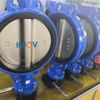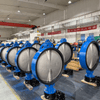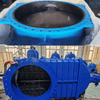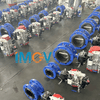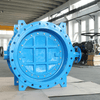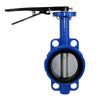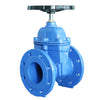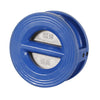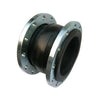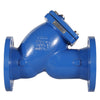Triple Eccentric Butterfly Valve: Design Advantages and Working Principle
The triple eccentric butterfly valve is a high-performance valve developed from the standard butterfly valve to meet the increasingly stringent process requirements.
Triple Eccentric Butterfly Valve VS Other Butterfly Valves
Since the butterfly valve was invented by the United States in the 1930s, it has evolved through concentric butterfly valves, single eccentric butterfly valves, double eccentric butterfly valves, and triple eccentric butterfly valves.

Source:https://www.youtube.com/watch?v=sYbehFeAHKc
In concentric butterfly valves, the disc and sealing surface are constantly squeezed and rubbed, leading to rapid wear and difficulty in opening and closing. The single eccentric butterfly valve reduces this squeezing through axial offset, but friction still occurs.
The double eccentric butterfly valve adds another offset in the radial direction, allowing the disc to quickly disengage from the sealing surface, significantly reducing wear, though precise closing is required.
To completely eliminate friction, the triple eccentric butterfly valve was developed. With a third offset, it ensures that the disc and sealing surface are entirely contact-free during operation, significantly enhancing sealing performance and extending service life.
Triple Eccentric Butterfly Valve Animation
Triple Offset Butterfly Valve Working
The three offsets in a triple eccentric valve are: shaft offset, sphere center offset, and sealing surface offset.
Offset 1: The centerline of the valve stem is offset from the centerline of the valve seat by a certain distance, ensuring the integrity of the sealing surface.
Offset 2: The centerline of the valve stem is offset from the centerline of the valve body, reducing the friction between the sealing components during opening and closing.
Offset 3: The centerline of the valve body is offset from the centerline of the conical sealing surface of the valve seat by a certain angle, allowing the sealing ring of the butterfly valve and the valve seat to quickly disengage or contact during opening and closing, ensuring no friction or squeezing between the sealing components.
Due to the third offset, the butterfly disc does not make any contact with the valve body's sealing surface during opening and closing, preventing wear from scraping and minimizing the torque required to operate the valve. This offset angle also creates a wedge-shaped surface seal, improving the butterfly valve's performance under high pressure differentials.
Triple Eccentric Butterfly Valve Design
The most notable feature of the triple eccentric butterfly valve is its non-interfering operation, meaning no scraping or wear occurs during opening and closing. Therefore, the design of the three offsets is crucial. The first offset is related to the structural dimensions of the valve body and the diameter of the valve stem. The second and third offsets are key parameters that ensure no interference during operation.
1.When the second offset is increased, it enlarges the gap between the butterfly disc and the valve body sealing surface, allowing the disc to disengage more easily. However, this design creates a larger unbalanced torque, increasing the overall operating torque. Therefore, while ensuring the disc quickly disengages from the valve body sealing surface, the second offset should be kept as small as possible.
2.If the angle of the third offset is too large, the butterfly disc's sealing ring will experience uneven forces, reducing performance under high-pressure differentials. Conversely, if the angle is too small, interference and scraping may occur, affecting sealing performance and shortening service life. For example, Vanessa, a renowned international manufacturer of triple eccentric butterfly valves from Italy, designs the third offset angle to be between 10° and 12°
Sealing Pair of Triple Eccentric Butterfly Valve
The sealing pairs of triple eccentric butterfly valves commonly include metal hard seals, non-metal soft seals, multi-layered seals, and elastic seals.
The choice of sealing pair depends mainly on the properties of the medium, temperature, and required leakage class. Generally, when the temperature does not exceed 200°C, the medium is clean without abrasive particles, and tight shutoff is required, a non-metal soft seal can be used.
In cases where the temperature is higher or the medium is abrasive, a metal hard seal is recommended. When using a metal hard seal, the sealing surface of the valve body needs to undergo hardening treatment, such as overlay welding or spraying hard alloys onto the valve body sealing surface, to increase surface hardness and enhance wear resistance.
In addition to the design points mentioned above, the design of the triple eccentric butterfly valve must also consider the impact of the fluid medium on the valve structure. For example, for coal powder, dust protection for the valve stem is required; for oxygen, static discharge for internal parts must be addressed; for fire-safe requirements, a dual soft and hard seal is necessary. Moreover, the valve stem must be designed to prevent blowout from internal pressure. During the design process, it is essential to take into account the actual process conditions and working environment as much as possible to ensure that the final product is safe, reliable, and suitable for the user's needs.
Triple Offset Butterfly Valve Advantages
- Excellent Sealing Performance: The sealing of a triple eccentric butterfly valve is achieved through the compression between the valve's sealing surfaces. The greater the closing torque, the higher the sealing level, making "zero leakage" possible.
- Zero Friction: The design reduces friction during the valve's opening and closing, significantly extending the valve's service life.
- High Flow Capacity: Due to the advantages of the triple eccentric structure, the valve's flow diameter is larger, providing a higher flow rate.
- No Dead Zone Design: With minimal friction between the disc and the valve seat, the valve can begin regulating flow almost from a 0-degree opening up to 90 degrees. Its control ratio is more than twice that of a standard butterfly valve, with the maximum control ratio exceeding 100:1.
- High Temperature and Pressure Resistance: Triple eccentric metal-sealed butterfly valves can operate across a wide range of temperatures and pressures, generally from -196°C to 650°C, and from PN10 to PN160 (ANSI CL 150 to CL1500).
- Long Service Life: The metal-to-metal sealing of the triple eccentric butterfly valve provides excellent wear resistance, maintaining its shape over long periods of operation. Additionally, the valve seat and sealing ring disengage without friction at the moment of opening, resulting in an extremely long lifespan.
- Adjustable Performance: The degree of opening and closing of the triple eccentric butterfly valve can be adjusted as needed, making it suitable for various industrial pipelines.

Triple Eccentric Butterfly Valves Disadvantages
- Thick Valve Disc Structure: The valve disc is relatively thick, resulting in higher flow resistance, which makes it unsuitable for small-diameter pipelines below DN200.
- Impact on Sealing in Normally Open Pipelines: In normally open pipelines, the sealing surface of the valve seat is directly exposed to the medium flow, which can wear down the multi-layer hard laminated sealing ring on the valve disc over time, affecting sealing performance.
- Potential for Leakage in Reverse Flow: The triple eccentric structure relies on the torque from the actuator to press the valve disc against the valve seat to achieve sealing. In the forward flow state, the higher the medium pressure, the tighter the sealing. However, in reverse flow, as the medium pressure increases, the contact pressure between the valve disc and the valve seat may become lower than the medium pressure, leading to leakage.
- Higher Cost: Due to its more complex structure compared to double eccentric butterfly valves, triple eccentric butterfly valves tend to be more expensive.
Triple Eccentric Butterfly Valves Applications
Petrochemical Industry: Triple eccentric butterfly valves are widely used in pipeline systems in the oil and chemical industries, for cutting off and regulating gases and liquids.
Water Treatment Industry: These valves can be applied in areas like municipal water and wastewater treatment, to regulate and filter water quality.
Food Industry: Triple eccentric butterfly valves are commonly used in the food industry, such as in the production of beer and beverages, for controlling flow and pressure during the manufacturing process.
Environmental Protection Industry: They are also widely used in the environmental sector, for controlling emissions in processes such as exhaust gas treatment and solid waste management.
With their frictionless design, superior sealing performance, and ability to handle extreme conditions, triple eccentric butterfly valves have become the preferred choice in many industries. Although they are relatively costly, their long service life and efficient operation make them the best option for complex working conditions.
Union Valve is a professional butterfly valve manufacturer in China, offering custom designs to meet the exact specifications of clients. For more information, please contact us.
Related Article:
-
Posted in
Advantages of triple eccentric butterfly valve, Triple Eccentric Butterfly Valve, Triple Eccentric Butterfly Valve work
